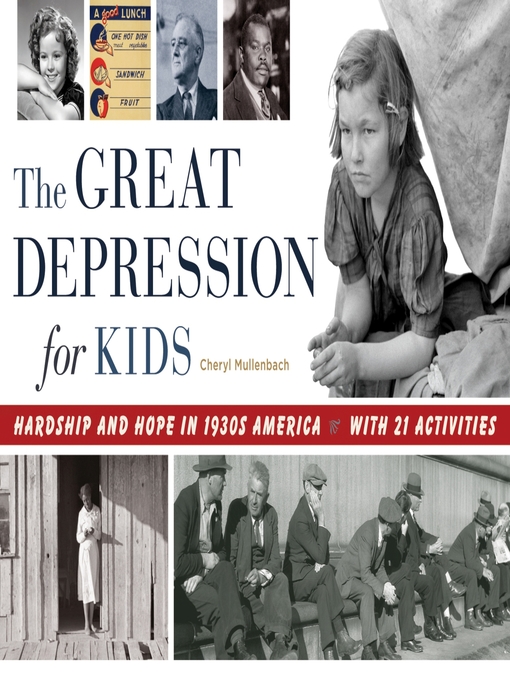- Available now
- Newly Added Ebooks
- New kids additions
- New teen additions
- Most popular
- See all ebooks collections
The Great Depression for Kids
Hardship and Hope in 1930s America, with 21 Activities
Have you ever wondered what it was like to live during the Great Depression? Perhaps you think of the stock market crash of 1929, unemployed workers standing in breadlines, and dust storms swirling on the Great Plains. But the 1930s were also a time when neighbors helped neighbors, librarians delivered books on horseback, and an army of young men rebuilt the nation's forests, roads, and parks. TheGreat Depression for Kids provides a balanced and realistic picture of an era rife with suffering but also deep-rooted with hope and generosity. Beginning with a full chapter on the 1920s, the book provides important background knowledge to help set the stage for an in-depth look at the decline of the economy and attempts at recovery over the next decade. Twenty-one hands-on activities invite young history buffs to understand and experience this important era in American history. Kids can recreate Depression glassware; simulate a windstorm; learn how to research, buy, and sell stocks; design a paper block quilt; play "round ball"; and much more.
-
Creators
-
Series
-
Publisher
-
Release date
July 1, 2015 -
Formats
-
Kindle Book
-
OverDrive Read
- ISBN: 9781613730546
- File size: 8123 KB
-
EPUB ebook
- ISBN: 9781613730546
- File size: 8123 KB
-
-
Languages
- English
-
Reviews
-
Publisher's Weekly
May 4, 2015
Opening and closing with Dorothea Lange’s instantly recognizable Migrant Mother photograph, Mullenbach presents a thorough but readily accessible account of the Great Depression. After a context-providing overview of the Roaring Twenties, Mullenbach explores the devastation brought on by the stock market crash, as well as the impact that events like the Dust Bowl had on an already dire economic situation. Though the topic is a necessarily somber one, Mullenbach also discusses how Americans held onto hope during the Depression. Included activities (such as making homemade whipped cream or writing a script for a radio play) offer additional ways for readers to engage with the historical material. Ages 9–up. -
School Library Journal
July 1, 2015
Gr 5-8-Mullenbach relates the trials endured by those living through the Great Depression, providing several related activities for readers. The book begins with an intriguing look at the photo The Migrant Mother and the story behind it. Mullenbach continues with a chapter about the 1920s, before delving into the stock market crash and the resulting woes, including the dust bowl, the plight of the migrant workers, and the New Deal programs. The information is solid, and Mullenbach provides facts not usually found elsewhere; for instance, she references Native Americans and the Bureau of Indian Affairs. However, the chapter about the 1920s seems unnecessary, as much of the information is unrelated to the subsequent narrative. A few paragraphs on the stock market crash are the only segue into the meat of the book; the rest of the chapter only serves to extend an already long narrative. While some of the recommended activities might be of interest to a motivated reader, others appear somewhat gratuitous (a paper airplane). Moreover, the stilted prose and dense text will turn away most readers. VERDICT Some of the activities will make this a possible supplemental aid in the classroom, but Russell Freedman's Children of the Great Depression (Clarion, 2005) is a better choice for those seeking material on this period.-Margaret Nunes, Gwinnett County Public Library, GA
Copyright 2015 School Library Journal, LLC Used with permission.
-
Booklist
August 1, 2015
Grades 4-7 It's not easy to present a subject as large as the Great Depression to kids who have little knowledge of the historical context, but this book offers a good deal of information in a well-organized way. An opening chapter on the 1920s sets the stage for later chapters on causes, social effects, urban life, rural life, children, the New Deal, and popular entertainment during the period. Throughout the book, Mullenbach refers to representative individuals by name and places their experiences in the framework of events. Often this technique works quite well, though sometimes the lack of detail makes it seem perfunctory. The best example brackets the main text: the book's introduction, which introduces Dorothea Lange's photo Migrant Mother, and postscript, which updates readers on what happened to the family pictured, effectively bring the broad historical narrative down to earth with a well-focused human story. The activities in the subtitle include making whipped cream, designing a paper quilt block, and interviewing an elder who lived through the period. A useful addition to history collections.(Reprinted with permission of Booklist, copyright 2015, American Library Association.)
-
Formats
- Kindle Book
- OverDrive Read
- EPUB ebook
subjects
Languages
- English
Loading
Why is availability limited?
×Availability can change throughout the month based on the library's budget. You can still place a hold on the title, and your hold will be automatically filled as soon as the title is available again.
The Kindle Book format for this title is not supported on:
×Read-along ebook
×The OverDrive Read format of this ebook has professional narration that plays while you read in your browser. Learn more here.



